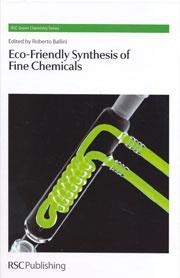Eco-friendly synthesis of fine chemicals
Eco-friendly synthesis of fine chemicals
Robert Ballini (ed)
Cambridge, UK: RSC Publishing 2009 | 312pp | ?99.95 (HB)
ISBN 9781847559081
Reviewed by Roger Sheldon

There is currently considerable interest in applying the principles of green chemistry and sustainability to industrial organic synthesis, particularly in the fine chemicals and pharmaceuticals industries. Hence this book is certainly opportune. As the editor states in the preface, ’it is intended to provide an overview of various processes and procedures devoted to the eco-sustainable syntheses of fine chemicals’.
The reader is introduced to the subject of green chemistry in an introduction to the first chapter which gives a good overview of organocatalysis and organometallic catalysis in non-conventional media. The concepts of E factors and atom economy and the 12 principles of green chemistry are briefly explained and the roles of catalysis and green solvents are introduced. It is a pity that a separate introductory chapter was not devoted to introducing the various aspects of eco-friendly synthesis in the context of fine chemicals synthesis.
This first chapter and another one devoted to task-specific ionic liquids as non-conventional solvents together comprise about 40 per cent of the book. Further chapters include the use of supported organic bases as heterogeneous catalysts and one entitled ’Green procedures for the synthesis of useful molecules avoiding hazardous solvents and toxic catalysts’. The latter covers a very mixed bag of reactions and techniques where the eco-friendly aspects are not always explained. A more focused presentation, clearly emphasising the greenness, would have been better.
Other chapters in the book cover a variety of techniques: photochemistry, high pressure and mechanochemical mixing and microwave irradiation. Although a case can be and is made for the eco-friendly aspects of these techniques, I would not have expected them to occupy such a dominant position. Finally, in a chapter on ’simple reactions for the synthesis of complex molecules’ the streamlining of syntheses of, for example, macrocycles is addressed.
In conclusion, although the book is a useful addition to the literature on green, eco-friendly organic synthesis the subject matter rather lacks coherence and, for a book with this title, an industrial perspective from somebody with direct experience with the industrial synthesis of fine chemicals is definitely missed.












No comments yet